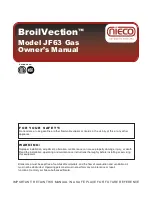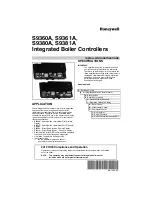
ENGLISH
6
C42-C42x -
Discharge and suction in regular smoke pipes (separated
but subject to similar wind conditions).
C52-C52x -
Separated discharge and suction on wall or roof, in areas
with different pressure levels. The discharge and suction lines must
never be placed on opposite walls.
C62-C62x -
Discharge and suction using pipes marketed and certified
separately (1856/1).
C82-C82x -
Discharge in a single or regular smoke pipe, and suction
on the wall.
C92-C92x -
Discharge on roof (similar to C32) and air suction via a
single existing smoke pipe.
Refer to the regulations in force.
For the indication of the maximum lengths of the single pipe, refer to
the following charts.
25 C.S.I.
air suction pipe length (m)
0
5
10
15
20
25
30
35
40
0
5
10
15
20
25
30
35
40
45
50
flue gas pipe length (m)
29 C.S.I.
0
2
4
6
8
10
12
14
16
18
20
22
0
2
4
6
8
10
12
14
16
18
20
22
24
26
28
flue gas pipe length (m)
air suction pipe length (m)
Twin pipes ø 80 with ducting Ø 60
Thanks to the boiler characteristics, a flue gas discharge pipe
Ø 80 can be
connected to the ducting ranges Ø 60. For the ducting, you are advised
to make a project calculation in order to respect the relevant standards in
force.
The table shows the standard configurations allowed.
Table of standard pipe configurations (*)
Air suction
1 bend - 90° ø 80
4.5m pipe ø 80
Flue gas discharge
1 bend - 90° ø 80
1m pipe ø 80
Reduction from ø 80 to ø 60
1 T-fitting ø 60
25 C.S.I.
Flange Ø 40
5m pipe ø 60 vertical
Flange Ø 45
9m pipe ø 60 vertical
No flange
17m pipe ø 60 vertical
29 C.S.I.
No flange
5m pipe ø 60 vertical
(*) Use flue gas system accessories in plastic (PP) for condensing boilers.
The configurations Ø 60 show test data verified in the laboratory.
In the case of installations that differ from those indicated in the “stand-
ard configuration” tables, refer to the equivalent linear lengths Ø 80 - Ø
60 below.
COMPONENT Ø 60
Linear equivalent in metres Ø80 (m)
Bend 45° Ø 60
5
Bend 90° Ø 60
8
Extension 0.5m Ø 60
2.5
Extension 1.0m Ø 60
5.5
Extension 2.0m Ø 60
12
In any case, the maximum lengths declared in the booklet are
guaranteed, and it is essential not to exceed them.
3.9 Filling the heating system (fig. 22)
Once the hydraulic connections have been carried out, fill the heating
system. This operation must be carried out with a cold system, follow-
ing these instructions:
- open the automatic air vent valve cap (
A
) by two or three turns
- make sure the cold water inlet tap is open
-
open the filling tap (
B
) until the pressure indicated by the water pres-
sure gauge is between 1 and 1.5 bar.
Once filling is complete, close the filling tap.
The boiler has an efficient air separator so no manual intervention is
needed.
The burner switches on only if the air relief phase is finished.
The correct operation of the external probe (supplied as an accessory)
is fundamental for good climatic control operation.
3.10 Draining the heating system (fig. 22)
To empty the system, proceed as follows:
- switch off the boiler
- loosen the boiler discharge tap (
C
)
- drain the lowest points of the system.
3.11 Draining the domestic hot water system (fig. 22)
When there is risk of frost, the domestic hot water system must be
emptied in the following way:
- turn off the main water supply tap
- turn on all the hot and cold water taps
- drain the lowest points.
When carrying out the discharge of the safety valve (D), it
must be connected to a suitable collection system. The man-
ufacturer is not responsible for possible damages due to
safety valve operation.
4 - IGNITION AND OPERATION
4.1 Preliminary checks
Before starting up the boiler, check:
a) that the supply networks data (electric, water, gas) corresponds to
the label data
b) that piping leaving the boiler is covered by thermal insulation
sheath
c) that flue gas extraction and air suction pipes work correctly
d) that conditions for regular maintenance are guaranteed if the boil-
er is placed inside or between furniture
e) the seal of the fuel adduction system
f) that fuel capacity corresponds to values requested by the boiler
g) that the fuel supply system has the correct capacity for the neces-
sary capacity to the boiler and that it has all the safety and control
devices prescribed by current regulations.
4.2 Appliance ignition
When the boiler is first started the siphon for collecting the con
-
densate is empty.
It is therefore indispensable to create a head of water filling the
siphon before starting up, following these instructions:
- remove the siphon by releasing it from the plastic pipe connect-
ing to the combustion chamber
- fill the siphon about 3/4” full with water, making sure it is free of
any impurities
- check the float of the plastic cylinder
- put back the siphon, being careful not to empty it, and secure it
with the clip.
The plastic cylinder inside the siphon has the job of preventing combu-
stible gas coming out into the surroundings if the appliance is started
without first creating the head of water in the siphon.
Repeat this operation during routine and extraordinary maintenance
operations.







































